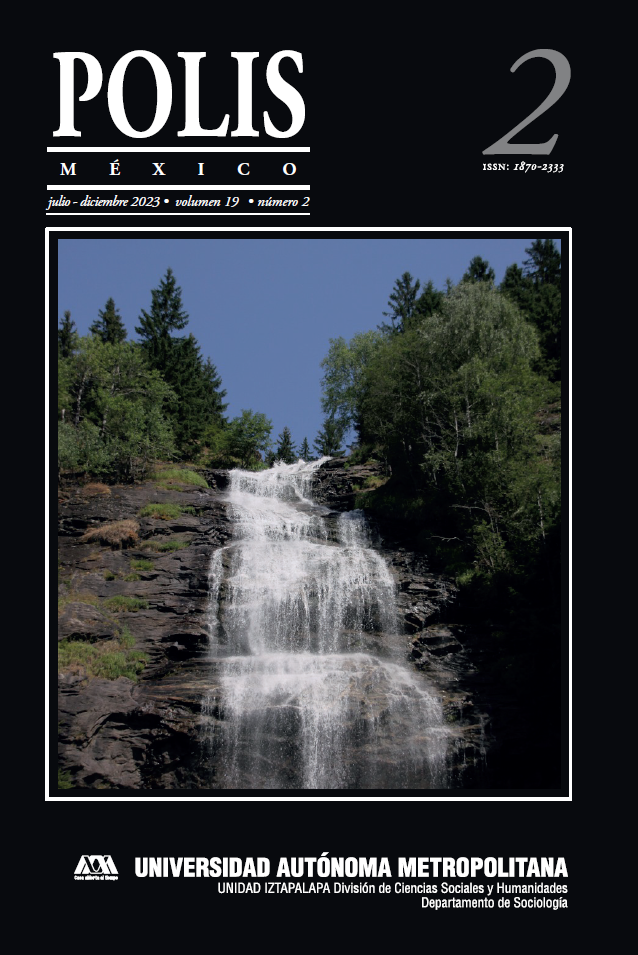APROBACIÓN PRESIDENCIAL Y ELECCIONES DISRUPTIVAS EN MÉXICO
Keywords:
Aprobación presidencial, elecciones disruptivas, elecciones fijas, series de tiempo.Abstract
¿De qué manera influyen los distintos tipos de elección presidencial en la tendencia subsecuente de la aprobación del presidente? Este artículo usa a México, con modelos de análisis de series temporales interrumpidas y los índices de aprobación presidencial trimestrales de 1995 a 2022 del Reforma, para analizar los efectos de las elecciones presidenciales (desde 2000) en la tendencia de la aprobación presidencial. Los resultados muestran que la variación de la aprobación del presidente es sensible a las elecciones presidenciales, la segunda tiene efectos estadísticamente significativos en la primera. Estos efectos no son homogéneos, y nos permiten hablar de elecciones presidenciables estables, de cambio, y disruptivas.
Downloads
References
Becketti, S. (2020). Introduction to Time Series Using Stata. Texas, Stata
Press.
Box, G. E. P. et al., (2016) Time Series Analysis: Forecasting and Control.
New Jersey: Wiley Series.
Brody, R. (1991). Assessing the President. Standford: Standford University
Press.
Buendía, J. (1996). “Economic Reform, Public Opinion and Presidential
Approval in Mexico 1988–1993.” Comparative Political Studies 29
(5): 566–591.
Campbell, A., et. al. (1960). The American Voter. Chicago: Chicago University
Press.
Cohen, J.. (2010). Going Local. Cambridge: Cambridge University Press.
Costas, P.. (2012). “Ex-Presidential Approval: Retrospective Evaluations
of Presidential Performance.” Presidential Studies Quarterly. Vol.
, no.4: 719-729.
Gómez-Vilchis, R. R. (2012a). “Changes in Perceptions of Corruption
and Presidential Approval.” Public Integrity, Fall, 14 (4): 341-361.
_____ (2012b). “Democratic Transition and Presidential Approval in
Mexico.” Mexican Studies, Winter, Vol. 28 (1): 43-72.
Hibbs, D., (1982). “The Dynamics of Political Support for American Presidents
Among Occupational and Partisan Groups.” American
Journal of Political Science 26 (2): 312-332.
Kaufman, R., and Zuckermann, L. (1998). “Attitudes toward Economic
Reform in Mexico: The Role of Political Orientations.” American
Political Science Review, Vol. 92 (2): 359-375.
Kernell, S. (1978). “Explaining Presidential Popularity.” American Political
Science Review 72 (2): 506-522.
Key, V. O. (1955). “A Theory of Critical Elections.” The Journal of Politics
1: 3–18.
Kinder, D. (1981). “Presidents, Prosperity and Public Opinion.” Public
Opinion Quarterly 45: 1-21.
Linden, A. (2015).” Conducting Interrupted Time-Series Analysis for Single
and Multiple-Group Comparisons.” The Stata Journal, Vol.
, No.2: 480-500
Magaloni, B. (2006). Voting for Autocracy. Cambridge: Cambridge University
Press.
McAvoy, G. (2008). “Substance versus Style: Distinguishing Presidential
Job Performance from Favorability. Presidential Studies Quarterly,
Vol. 38, no. 2: 284-299.
Molinar, J. and Weldon J. (2014). “Elecciones de 1988 en México: Crisis
del Autoritarismo”. Revista Mexicana de Opinión Pública: 17:
-191.
Moreno, A. (2009). La Decisión Electoral. Votantes, Partidos y Democracia
en México. Ciudad de México: Miguel ángel Porrúa.
_____, (2018). El Cambio Electoral: Votantes, Encuestas y Democracia en
México. Ciudad de México: Fondo de Cultura Económica
Mueller, J. (1973). War, Presidents and Public Opinion. Lanham,
Maryland: University Press of America
Ostrom, C. and Dennis, S. (1985). “Promise and Performance”¦” American
Political Science Review 79: 334-358.
Page, B. (1978). Choices and Echoes in Presidential Elections. Chicago:
University of Chicago Press.
Pomper, G. (1967). “Classification of Presidential Elections.” The Journal
of Politics, Vol. 29, No. 3: 535-566.
Somuano, M. F. (2018). “Aprobar al Presidente. Una Comparación entre
Felipe Calderón y Enrique Peña Nieto.” Foro Internacional, 234,
lViii, 2018 (4): 629-670.
Stimson, J. A. (1976). “Public Support for American Presidents.” Public
Opinion Quarterly, 40: 1-21.
_____, (1999). Public Opinion in America. Moods, Cycles and Swings. Colorado:
Westview Press
Tedin, K. (1986). “Change and Stability in Presidential Popularity at the
Individua Level.” Public Opinion Quarterly 40: 1-21.
Villarreal, A. (1999). “Public Opinion of the Economy and the President
among Mexico City Residents: The Salinas Sexenio.” Latin
American Research Review, 34.2: 132–151.
Wooldridge, J. (2001). Introducción a la Econometría. México: Thomson/
Learning



